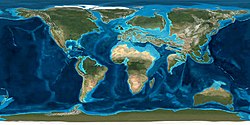New Mars Forums
You are not logged in.
- Topics: Active | Unanswered
Announcement
#1 2023-08-19 23:18:29
- Void
- Member
- Registered: 2011-12-29
- Posts: 7,138
Climate Variations, Albedo, and Atmospheric Displacement.
Kill this topic if you want to.
Here I am trying to better understand climate in relationship to Albedo and Atmospheric Displacement. Because I watched a video and then looked at Albedo in the wiki closer, it popped into my head an improved notion of feedbacks.
Here is about Albedo: https://en.wikipedia.org/wiki/Albedo
Quote:
Sample albedos
Surface Typical
albedo
Fresh asphalt 0.04[7]
Open ocean 0.06[8]
Worn asphalt 0.12[7]
Conifer forest,
summer 0.08,[9] 0.09 to 0.15[10]
Deciduous forest 0.15 to 0.18[10]
Bare soil 0.17[11]
Green grass 0.25[11]
Desert sand 0.40[12]
New concrete 0.55[11]
Ocean ice 0.50 to 0.70[11]
Fresh snow 0.80[11]
Aluminum 0.85[13][14]
We typically almost only think of the greenhouse effect as being either a planets atmosphere or for the Blab Meisters, it is CO2, and Methane, and maybe a bit of water vapor in the atmosphere.
I will define atmospheric displacement.
There are some substances that migrate over time. Among them is ice and water. Where they are situated determines the amount of atmospheric column over Land, Ice, and Sea. In an ice age, I expect a greater atmospheric column over the sea, and a lesser one over ice caps. This should help the seas to warm up more than they would as the atmospheric greenhouse effect is greater. And as air sinks into the shrinking ocean basins, less air will be over the high locations including the growing ice caps.
But while this is happening, a different area total of ice will occur, and also a different area of water will occur.
Ice can pile up or spread out. Water level for the oceans is very similar for all the oceans that are having the same surface level.
https://en.wikipedia.org/wiki/Albedo
Quote:
Earth's average surface temperature due to its albedo and the greenhouse effect is currently about 15 °C (59 °F). If Earth were frozen entirely (and hence be more reflective), the average temperature of the planet would drop below −40 °C (−40 °F).[18] If only the continental land masses became covered by glaciers, the mean temperature of the planet would drop to about 0 °C (32 °F).[19] In contrast, if the entire Earth was covered by water – a so-called ocean planet – the average temperature on the planet would rise to almost 27 °C (81 °F).[20]
So, while most people are focused on the melting of ice, actually it can also be the increase in the sea's area that can make the Albedo collect more heat. But at the same time, the atmospheric column over the oceans is thinning, so that would have a cooling effect, but with that happening, more air is pushed up onto land and also over the ice caps.
For the moment, I don't know if I have proper grasp of this, but it suggests to me that Earth's climate would be prone to oscillate. And I don't know what caused the last ice age to end but it seems sensible to me that our climate may still be oscillating into a warmer one. I am thinking that we should not be expecting a stable climate, with or without a CO2 greenhouse effect.
So, what limits a warming oscillation? I am aware to some degree of orbital factors.
So, in this video, it is suggested that the difference in temperature between the Equator and Poles is about 60 during an ice age, about 40 now, and about 20, in a previous era a long time ago. Eocene? https://en.wikipedia.org/wiki/Eocene
Image Quote: 
Quote:
Map of the Earth 50 mya
This block suggests that the amount of Carbon available to plants influences land albedo:
Conifer forest,
summer 0.08,[9] 0.09 to 0.15[10]
Deciduous forest 0.15 to 0.18[10]
Bare soil 0.17[11]
Green grass 0.25[11]
Desert sand 0.40[12]
The more Carbon, the less rain needed to grow plants. So, not only ice would reflect light into space, but dry grass, and snow covered grass, and desert sand.
https://wattsupwiththat.com/2017/06/30/ … ittle-co2/
Quote:
What few realize, however, is that during the last Ice Age too little CO2 in the air almost eradicated mankind. That’s when much-colder water in oceans (that were 400 feet shallower than today) sucked most of the carbon dioxide from the air; half of North America, Europe and Asia were buried under mile-high glaciers that obliterated everything in their paths; and bitterly cold temperatures further retarded plant growth.
In fact, Earth’s atmosphere had only about 180 parts per million CO2, compared to today’s 400 ppm: 0.018% then versus 0.040% today.
The Ice Age’s combined horrors – intense cold, permanent drought and CO2 starvation – killed most of the plants on Earth. Only a few trees survived, in the mildest climates. Much of the planet’s grass turned to tundra, which is much less nourishing to the herbivores prehistoric humans depended on for food and fur. Recent Cambridge University studies conclude that only about 100,000 humans were left alive worldwide when the current interglacial warming mercifully began.
So, it sounds like during the last ice age the cold water of the oceans sucked so much CO2 out of the atmosphere that the plants struggled to live.
I am still struggling to learn.
Climate Jordan Peterson: https://www.youtube.com/watch?v=KhCKYvETYDc
Done
You may notice that I have only so far indicated that I think our climate like to wobble. Oscillate. I need to think on this some more.
Done.
Last edited by Void (2023-08-20 00:05:57)
Done.
Offline